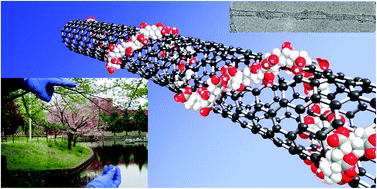A highly durable, stretchable, transparent and conductive carbon nanotube–polymeric acid hybrid film†
Abstract
We demonstrate a highly durable and stretchable carbon nanotube (CNT)–polymer transparent conductive film by utilizing polyacrylic acid wrapping to simultaneously disperse and dope CNTs. This novel strategy not only enables an easy and industrially scalable process where neither removal of dispersant nor further doping is necessary, but also results in a boost in the conductivity and durability, and correspondingly it provides infinite versatility for various applications. A significant improvement in conductivity being comparable to acid doping is achieved through a hybrid structure in which a polyacrylic acid monolayer helically and partially wraps the CNT surface. The optimum films show sheet resistances of 150 and 60 Ω per square at 91% and 84% optical transmittances, respectively. Notably, the sheet resistances of hybrid films remain almost constant after aging tests under conditions of 85 °C and 85% relative humidity for more than 3000 h, and bending and stretching tests of more than 1 million cycles, suggesting outstanding long-term stability and record-high flexibility and stretchability. Therefore, the highly transparent conductive film, combined with excellent long-term and mechanical durability, and surprisingly easy processability, opens new routes for next-generation wearable electronics and bioelectronics.



 Please wait while we load your content...
Please wait while we load your content...